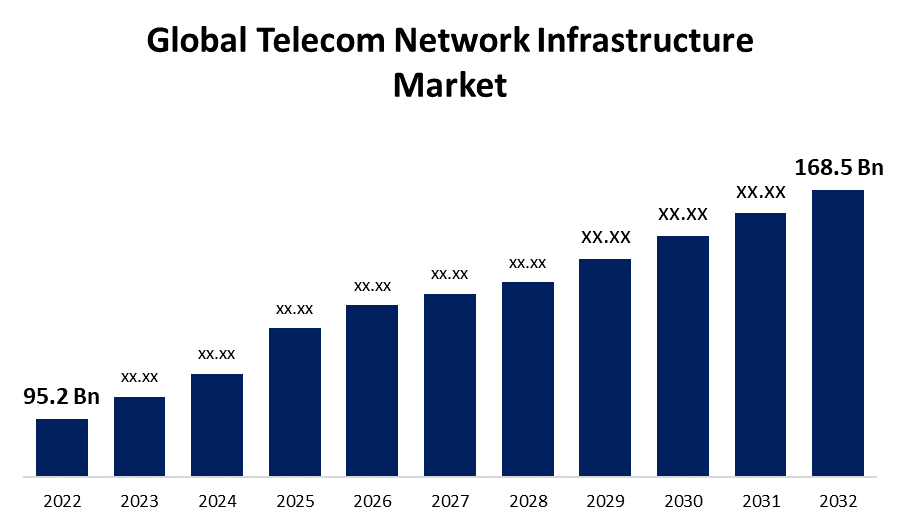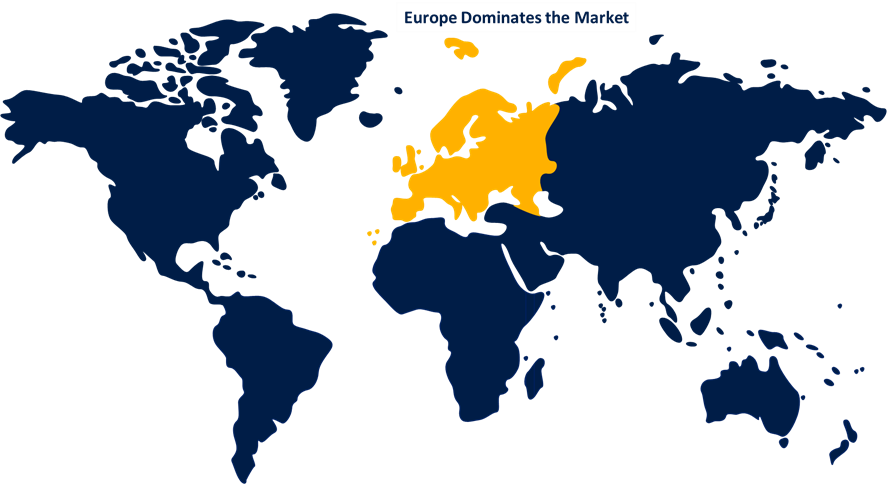Global Telecom Network Infrastructure Market Size, Share, and COVID-19 Impact Analysis, By Component (Product, Service), By Connectivity Technology (2G, 3G, 4G/LTE, & 5G), By End User (Telecom Operators and Enterprises), By Region (North America, Europe, Asia-Pacific, Latin America, Middle East, and Africa), Analysis and Forecast 2022 – 2032
Industry: Electronics, ICT & MediaGlobal Telecom Network Infrastructure Market Insights Forecasts to 2032
- The Global Telecom Network Infrastructure Market Size was valued at USD 95.2 Billion in 2022.
- The Market is Growing at a CAGR of 5.8% from 2022 to 2032.
- The worldwide Telecom Network Infrastructure Market size is expected to reach USD 168.5 Billion by 2032.
- Asia Pacific is expected to grow the fastest during the forecast period.

Get more details on this report -
The Global Telecom Network Infrastructure Market Size is expected to reach USD 168.5 Billion by 2032, at a CAGR of 5.8% during the forecast period 2022 to 2032.
Market Overview
Telecom network infrastructure is a physical network made up of a collection of nodes connected by connections that are used to transmit audio, video, or data messages from one node to another via several network hops. These are two-way transmission technologies that permit the analog or digital transfer of electromagnetic or optical signals. For employees to access information, send and receive emails, participate in teleconferences, and advance joint ventures, voice over internet protocol (VoIP) demand and cloud-based solutions in commercial enterprises and the healthcare sector, among other industries, require widespread adoption of wireless telecom network infrastructure. Due to increased usage of mobile internet and data-intensive applications, the significant increase in smartphone sales throughout the world has resulted in significant data traffic. Global telecom infrastructure development is predicted to accelerate due to the data traffic's impressive rise. Additionally, telecom operators have been compelled to build strong telecom infrastructure to guarantee enhanced cellular coverage, particularly in developing and expanding economies like India and China, due to the rise in digital literacy and the use of smartphones in rural areas.
Report Coverage
This research report categorizes the global telecom network infrastructure market based on various segments and regions and forecasts revenue growth and analyses trends in each submarket. The report analyses the key growth drivers, opportunities, and challenges influencing the global telecom network infrastructure market. Recent market developments and competitive strategies such as expansion, product launch, and development, partnership, merger, and acquisition have been included to draw the competitive landscape in the market. The report strategically identifies and profiles the key market players and analyses their core competencies in each sub-segment of the global telecom network infrastructure market. Technological innovation and advancement will further optimize the performance of the product, enabling it to acquire a wider range of applications in the downstream market.
Global Telecom Network Infrastructure Market Report Coverage
| Report Coverage | Details |
|---|---|
| Base Year: | 2022 |
| Market Size in 2022: | USD 95.2 Bn |
| Forecast Period: | 2022 – 2032 |
| Forecast Period CAGR 2022 – 2032 : | 5.8% |
| 022 – 2032 Value Projection: | USD 168.5 Bn |
| Historical Data for: | 2018-2021 |
| No. of Pages: | 200 |
| Tables, Charts & Figures: | 130 |
| Segments covered: | By Component, By Connectivity Technology , By End User, By Region. |
| Companies covered:: | Qualcomm Technologies Inc., Samsung Electronics Co. Ltd., Sprint Corporation, Cisco Systems Inc., Nokia Corporation Inc., Huawei Technologies Co. Ltd., Altiostar Networks Inc., Check Point Software Technologies Ltd., ZTE Corporation, Ciena Corporation, Fortinet Inc. |
| Pitfalls & Challenges: | COVID-19 Empact, Challenge, Future, Growth, & Analysis |
Get more details on this report -
Driving Factors
The total demand for telecom network infrastructure solutions is expected to be driven by the rising need for better cellular coverage. Because base stations are simple to set up and provide a reliable connection, governments supporting 5G broadband services are encouraging individuals to use them. Many different services are expected to grow with the introduction of high-speed internet in metropolitan areas. Also, the need for telecom network infrastructure solutions is being fueled by the increased use of faster internet connections and smartphones. Global telecom infrastructure development is expected to be boosted by the striking increase in data traffic. Moreover, the increased prevalence of smartphone technology and the growing number of younger and older users who use it are projected to have a beneficial effect on the demand for telecom network infrastructure.
Restraining Factors
Telecom network infrastructure market size growth has been hampered by factors such as general business model change, interoperability challenges, a skilled labor shortage, and the proliferation of cybercriminals who have easy access to critical data and information. Also, the high cost of adopting strategies and time-consuming processes is the main factor restraining the growth of the telecom infrastructure market. In addition, the expansion of the telecom network infrastructure industry may be hampered by the lack of consistency in spectrum allocation.
Market Segmentation
- In 2022,the product segment is dominating the market with the largest market share over the forecast period.
Based on components, the global telecom network infrastructure market is into different segments such as products and services. Among these segments, the product segment will grow at 5.5% CAGR during the forecast period. because the demand for better cellular networks has been rising as well, particularly in remote and difficult-to-reach locations, as smartphone usage for daily tasks increases and digitalization is being pushed around the globe. By 2032, segment share might increase due to the growing need for additional base stations to expand network coverage and the growing reliance on internet-based services in light of the COVID-19 pandemic.
- In 2022, the 4G/LTE segment is influencing the largest market growth during the forecast period.
Based on the connectivity technology, the market for global telecom network infrastructure market is segmented into different categories including 2G, 3G, 4G/LTE, and 5G. The 4G/LTE segment held the highest market share during the forecast period. With the development of 4G, which delivers quicker internet services and improved cellular coverage, 3G technology was improved. 4G services are expected to have sustained expansion as the necessary 5G infrastructure is still being deployed. To meet the rising demand for fast internet and hasten the country's digitization, the Indian government approved a $3 billion initiative in July 2022 to spread 4G services throughout all villages in the nation.
- In 2022, the enterprise segment is dominating the largest market share over the forecast period.
Based on end users, the global telecom network infrastructure market is bifurcated into different segments such as telecom operators and enterprises. Among these, the enterprises are leading the market growth during the forecast period, due to an increase in cellular device use and a surge in demand for cutting-edge communication infrastructure. Many companies are attempting to move their core operations to cloud and hybrid digital platforms, which call for strong networks to make it simple to access data inside a network. All communication-related issues are handled by these networks, which are also required for bettering business data management.
Regional Segment Analysis of the global telecom network infrastructure market
- North America (U.S., Canada, Mexico)
- Europe (Germany, France, U.K., Italy, Spain, Rest of Europe)
- Asia-Pacific (China, Japan, India, Rest of APAC)
- South America (Brazil and the Rest of South America)
- The Middle East and Africa (UAE, South Africa, Rest of MEA)
Europe dominates the global telecom network infrastructure market with the largest market growth over the forecast period

Get more details on this report -
The market for telecom network infrastructure in Europe generated USD 20 billion in sales due to measures to improve broadband access. The European Commission recently unveiled the EU's broadband plan in January 2022 to advance both the region's digital transformation and the goal of the European Gigabit Society for 2025. With the use of high-capacity networks, the Broadband Europe initiative will link businesses and consumers to foster innovation in goods, services, and apps.
The Asia Pacific telecom network infrastructure market is expected to grow during the forecast period. In addition to helping the telecom operators recover from the negative impacts of Covid-19, the Chinese government and business sector are supporting the market for telecom network infrastructure. It is projected that the Chinese market would benefit from the country's fast-expanding digital business models as well as its leading communications and outsourcing infrastructures.
Competitive Analysis
The report offers the appropriate analysis of the key organizations/companies involved within the global telecom network infrastructure market along with a comparative evaluation primarily based on their product offering, business overviews, geographic presence, enterprise strategies, segment market share, and SWOT analysis. The report also provides an elaborative analysis focusing on the current news and developments of the companies, which includes product development, innovations, joint ventures, partnerships, mergers & acquisitions, strategic alliances, and others. This allows for the evaluation of the overall competition within the market.
List of Key Companies
- Qualcomm Technologies Inc.
- Samsung Electronics Co. Ltd.
- Sprint Corporation
- Cisco Systems Inc.
- Nokia Corporation Inc.
- Huawei Technologies Co. Ltd.
- Altiostar Networks Inc.
- Check Point Software Technologies Ltd.
- ZTE Corporation
- Ciena Corporation
- Fortinet Inc.
Key Target Audience
- Market Players
- Investors
- End-users
- Government Authorities
- Consulting And Research Firm
- Venture capitalists
- Value-Added Resellers (VARs)
Recent Development
- In April 2022, the cellular ecosystem is regulated by Qualcomm Technologies Inc.'s new 5G infrastructure platforms, which also enable vRAN and interoperable networks. The platform is probably protected against harmful cyberattacks.
Market Segment
This study forecasts revenue at global, regional, and country levels from 2022 to 2032. Spherical Insights has segmented the Global Telecom Network Infrastructure Market based on the below-mentioned segments:
Global Telecom Network Infrastructure Market, By Component
- Product
- Base Stations
- Macrocell
- Microcell
- Picocell
- Femtocell
- Infrastructure components
- Routers & Switches
- Access Points
- Firewalls
- Base Stations
- Service
- Network Consulting
- Integration & Deployment
- Support & Maintenance
Global Telecom Network Infrastructure Market, By Connectivity Technology
- 2G
- 3G
- 4G/LTE
- 5G
Global Telecom Network Infrastructure Market, By End Users
- Telecom Operators
- Enterprises
Telecom Network Infrastructure Market, By Regional Analysis
- North America
- US
- Canada
- Mexico
- Europe
- Germany
- Uk
- France
- Italy
- Spain
- Russia
- Rest of Europe
- Asia Pacific
- China
- Japan
- India
- South Korea
- Australia
- Rest of Asia Pacific
- South America
- Brazil
- Argentina
- Rest of South America
- Middle East & Africa
- UAE
- Saudi Arabia
- Qatar
- South Africa
- Rest of the Middle East & Africa
Need help to buy this report?